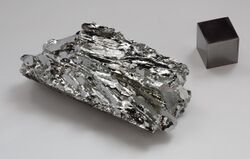Molybdenum, 42 Molybdenum Pronunciation (mə-LIB -də-nəm Appearance gray metallic Standard atomic weight A r, std (Mo) [1] Molybdenum in the periodic table
Atomic number (Z ) 42 Group group 6 Period period 5 Block d-block Element category d-block Electron configuration [Kr ] 4d5 5s1 Electrons per shell 2, 8, 18, 13, 1 Physical properties Phase at STP solid Melting point 2896 K (2623 °C, 4753 °F) Boiling point 4912 K (4639 °C, 8382 °F) Density (near r.t. ) 10.28 g/cm3 when liquid (at m.p. ) 9.33 g/cm3 Heat of fusion 37.48 kJ/mol Heat of vaporization 598 kJ/mol Molar heat capacity 24.06 J/(mol·K) Vapor pressure
P (Pa)
1
10
100
1 k
10 k
100 k
at T (K)
2742
2994
3312
3707
4212
4879
Atomic properties Oxidation states −4, −2, −1, 0, +1,[2] +4 +6 acidic oxide) Electronegativity Pauling scale: 2.16 Ionization energies 1st: 684.3 kJ/mol 2nd: 1560 kJ/mol 3rd: 2618 kJ/mol Atomic radius empirical: 139 pm Covalent radius 154±5 pm Spectral lines of molybdenumOther properties Natural occurrence primordial Crystal structure body-centered cubic (bcc) Speed of sound thin rod 5400 m/s (at r.t. ) Thermal expansion 4.8 µm/(m·K) (at 25 °C) Thermal conductivity 138 W/(m·K) Thermal diffusivity 54.3 mm2 /s (at 300 K)[3] Electrical resistivity 53.4 nΩ·m (at 20 °C) Magnetic ordering paramagnetic [4] Magnetic susceptibility +89.0·10−6 cm3 /mol (298 K)[5] Young's modulus 329 GPa Shear modulus 126 GPa Bulk modulus 230 GPa Poisson ratio 0.31 Mohs hardness 5.5 Vickers hardness 1400–2740 MPa Brinell hardness 1370–2500 MPa CAS Number 7439-98-7 History Discovery Carl Wilhelm Scheele (1778) First isolation Peter Jacob Hjelm (1781) Main isotopes of molybdenum
Category: Molybdenum view · talk · edit references
Mo
data m.p. cat
in
calc from C
diff
report
ref
C
2623
—
—
K
2896
2896
0
F
4753
4753
0
max precision
0
WD
input
C: 2623, K: 2896, F: 4753
comment
Mo
data b.p. cat
in
calc from C
diff
report
ref
C
4639
—
—
K
4912
4912
0
F
8382
8382
0
max precision
0
WD
input
C: 4639, K: 4912, F: 8382
comment
References These references will appear in the article, but this list appears only on this page.
↑ Meija, Juris; Coplen, Tyler B.; Berglund, Michael; Brand, Willi A.; De Bièvre, Paul; Gröning, Manfred; Holden, Norman E.; Irrgeher, Johanna et al . (2016). "Atomic weights of the elements 2013 (IUPAC Technical Report)". Pure and Applied Chemistry 88 (3): 265–91. doi :10.1515/pac-2015-0305 . ↑ "Molybdenum: molybdenum(I) fluoride compound data" . OpenMOPAC.net. http://openmopac.net/data_normal/molybdenum(i)%20fluoride_jmol.html . ↑ Lindemann, A.; Blumm, J. (2009). Measurement of the Thermophysical Properties of Pure Molybdenum . 3 . 17th Plansee Seminar. ↑ Lide, D. R., ed (2005). "Magnetic susceptibility of the elements and inorganic compounds" . CRC Handbook of Chemistry and Physics (86th ed.). Boca Raton (FL): CRC Press. ISBN 0-8493-0486-5 . https://web.archive.org/web/20110303222309/http://www-d0.fnal.gov/hardware/cal/lvps_info/engineering/elementmagn.pdf . ↑ Weast, Robert (1984). CRC, Handbook of Chemistry and Physics . Boca Raton, Florida: Chemical Rubber Company Publishing. pp. E110. ISBN 0-8493-0464-4 . Template:Documentation


